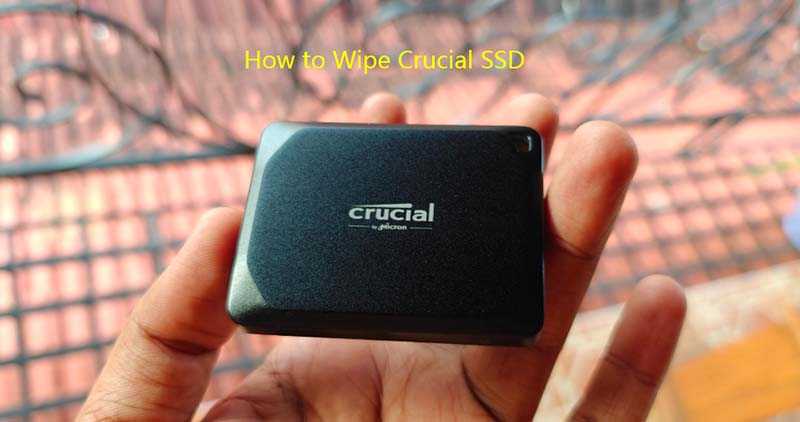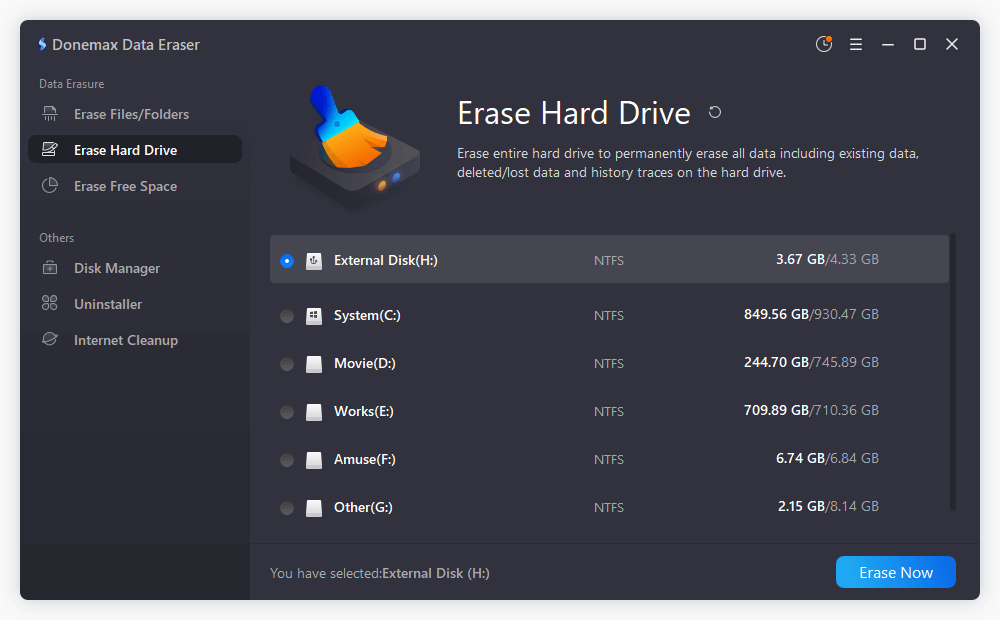PAGE CONTENT:
Are you planning to get a new system or get rid of an old one? It's important to safely wipe your SSD (such as Crucial SSD) before you throw it away or sell it, but you might be missing this step. The super-fast storage in most new systems is called an SSD. Unlike old hard drives that spin, it can hide your data even after you format it! In other words, anyone with a little tech know-how can get back your files, photos, and papers.
Don't worry, we'll take care of you. No matter how tech-savvy you are, this guide will show you how to wipe your Crucial SSD safely. Let's make sure your info is safe and your upgrade goes smoothly!
Why Should Wipe Your Crucial SSD?
The data on your SSD isn't erased right away when you delete files or reformat the drive. Instead, the operating system marks the room the files take up as free so that new data can be added. Until then, the original material is still there and can be recovered by bad people using special software.
That is a big risk, especially when SSDs are thrown away or used for something else. Bad security can happen if private data gets into the wrong hands, causing data breaches, identity theft, and other problems. SSDs must be fully erased before they are thrown away or used again to protect private data and follow privacy laws.
Challenges in Wiping Crucial SSDs
SSDs are different from regular hard drives (HDDs) when it comes to erasing data because they store data in flash memory. It's harder to wipe SSDs safely because of how they handle data, such as with Wear-Leveling and garbage collection methods. Additionally, SSDs frequently have extra room that users can't see, which makes it even harder to delete data.
Like SSDs from other brands, Crucial SSDs use cutting-edge technologies to improve speed and reliability. These features are helpful when things are running normally, but they can make it hard to delete data safely. Using the right methods and tools ensures data is completely cleaned.
Why Traditional Wiping Methods Fall Short?
For SSDs, standard data-erasing methods, like formatting the drive or removing files, don't work. These methods only change the file system table, which means they delete the map showing where your data is stored. The data stays on the flash memory cells until new data is written over them.
Here are some reasons why old ways don't work:
- Wear Leveling: Wear Leveling is used by SSDs to spread writes across the memory cells and make them last longer. When you delete a file, the controller might not quickly add new data over top of the old data. If the wear Leveling program says so, it might write new data to a different spot instead.
- TRIM Command: The TRIM command tells the operating system to tell the SSD driver about data blocks that aren't being used. This lets the controller collect garbage in the best way possible, which speeds things up. The TRIM order, on the other hand, does not delete the data; it only lets the blocks be written over.
As a result, formatting or removing files alone leaves your data open to being recovered. To securely delete data from your Crucial SSD, you must use methods targeting the data on the flash memory cells.

Step-by-Step Guide to Securely Wiping Crucial SSDs
1. Save important files:
Back up any important files or data on the SSD before you start the data-wiping process. As soon as the wiping process starts, all the data will be gone for good.
2. Turn off BitLocker or FileVault:
If your Crucial SSD is protected with BitLocker (on Windows) or FileVault (on macOS), you must decrypt it before you wipe it. Otherwise, you might be unable to erase the information.
Use the Secure Erase tool if it's available. Some Crucial SSD models have Secure Erase built in, which lets you delete everything from the drive quickly and safely. Here's what you need to do to use this feature:
- Please turn off your computer and unplug all its drives to prevent your data from getting lost by accident.
- You can start up your machine in either BIOS or UEFI mode.
- You can usually find the Secure Erase in Storage or Security settings.
- Choose the Crucial SSD you want to erase, and then follow the steps on the screen to start the Secure Erase process.
After the process is done, the SSD will be back to how it was when it came from the source, with all of its data safely erased.
3. Use software to erase data:
You can use third-party data-erasing software if your Crucial SSD doesn't have Secure Erase built in or if you'd like a more thorough way to delete data. Some popular choices are:
- Donemax Data Eraser
- Parted Magic
- DBAN (Darik's Boot and Nuke)
- Blancco Drive Eraser
- Secure Erase+ by Crucial (made just for Crucial SSDs)
These software programs have advanced features and formulas that ensure all your data is deleted safely and completely. Follow the software's directions to make a bootable USB drive or CD/DVD and start the wiping process.
Here, you can download Donemax Data Eraser to help you securely wipe Crucial SSD and permanently erase all data from it.
Donemax Data Eraser
- Permanently erase data from Crucial internal SSD or external SSD.
- Certified data erasure standards including Peter Gutmann, U.S. Army AR380-19, DoD 5220.22-M ECE, etc.
- Once the data is erased by Donemax Data Eraser, the data is lost for good, can’t be recovered by any method.
- 100% safe SSD erasure software, no physical damage.
Download and install Donemax Data Eraser on your computer, then open it, choose Wipe Hard Drive mode. Select the Crucial SSD, click on Erase Now button.

4. Check for Erasure of Data:
Once the wiping process is done, it's important to ensure that all the data has been deleted safely. You can do this by using data recovery tools to get back the files you deleted. If no recovered data is found, the data is erased successfully.
If you have wiped the Crucial SSD with Donemax Data Eraser, the data stored on the Crucial SSD is lost permanently, and unrecoverable. It is strongly recommended to wipe your Crucial SSD before you sell, donate or dispose of the old Crucial SSD.
5. Throw away or use the SSD again:
Once the Crucial SSD has been properly erased, you can safely throw it away or use it for something else. If you sell or give the SSD to someone else, ensure they know the drive has been erased and is safe to use.
Conclusion:
Correctly Wiping Crucial SSDs is important for keeping private data safe and stopping people from getting to it without permission. If you follow the steps in this guide, you can be sure that all the data on your Crucial SSD is deleted safely, whether you're getting rid of it or using it for something else.
Always be careful when erasing data, and ensure you have a backup of any important files before you start the wiping process. With the right tools and know-how, you can protect your data and stay in line with privacy laws.
Donemax Data Eraser is a 100% safe SSD wipe software. You can use this software to securely wipe the Crucial SSD, permanently erasing all data from it. Once the data is erased by Donemax Data Eraser, the data is gone for good, no way to recover it.
Related Articles
- Jul 27, 2025How to Wipe FAT32 Drive on Windows or macOS?
- Sep 04, 2025How to Wipe C Drive on Windows 11/10/8/7?
- Jan 10, 2024Windows 11 Factory Reset: Step-by-step Detailed Guide
- May 22, 2025Format a USB Drive to FAT32 on Windows 11 / 10 / 8 / 7
- Jan 12, 2025How to Securely Wipe Samsung SSD before Disposal? [4 Reliable Methods]
- Apr 25, 2025How to Make Deleted Data and Formatted Data Be Unrecoverable?

Maria
Maria is one of the senior writers & editors of Donemax who lives and works in Sydney, Australia. She loves PC, Mac and Internet Technology. She has 6 years of writing articles about data recovery on PC/Mac, disk cloning solution, data eraser and computer OS optimization, etc. She is also interested in testing various software and digital products.

Gerhard Chou
In order to effectively solve the problems for our customers, every article and troubleshooting solution published on our website has been strictly tested and practiced. Our editors love researching and using computers and testing software, and are willing to help computer users with their problems
